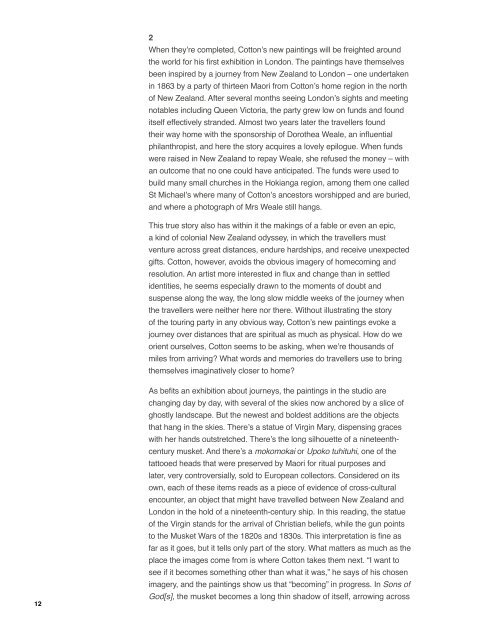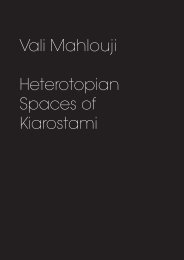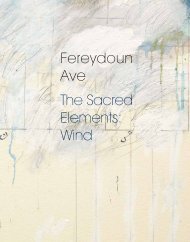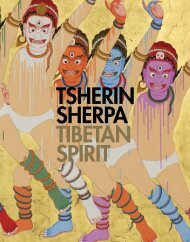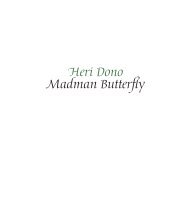Shane Cotton To and Fro
Untitled - Rossi & Rossi
Untitled - Rossi & Rossi
- No tags were found...
You also want an ePaper? Increase the reach of your titles
YUMPU automatically turns print PDFs into web optimized ePapers that Google loves.
2<br />
When they’re completed, <strong>Cotton</strong>’s new paintings will be freighted around<br />
the world for his first exhibition in London. The paintings have themselves<br />
been inspired by a journey from New Zeal<strong>and</strong> to London – one undertaken<br />
in 1863 by a party of thirteen Maori from <strong>Cotton</strong>’s home region in the north<br />
of New Zeal<strong>and</strong>. After several months seeing London’s sights <strong>and</strong> meeting<br />
notables including Queen Victoria, the party grew low on funds <strong>and</strong> found<br />
itself effectively str<strong>and</strong>ed. Almost two years later the travellers found<br />
their way home with the sponsorship of Dorothea Weale, an influential<br />
philanthropist, <strong>and</strong> here the story acquires a lovely epilogue. When funds<br />
were raised in New Zeal<strong>and</strong> to repay Weale, she refused the money – with<br />
an outcome that no one could have anticipated. The funds were used to<br />
build many small churches in the Hokianga region, among them one called<br />
St Michael’s where many of <strong>Cotton</strong>’s ancestors worshipped <strong>and</strong> are buried,<br />
<strong>and</strong> where a photograph of Mrs Weale still hangs.<br />
This true story also has within it the makings of a fable or even an epic,<br />
a kind of colonial New Zeal<strong>and</strong> odyssey, in which the travellers must<br />
venture across great distances, endure hardships, <strong>and</strong> receive unexpected<br />
gifts. <strong>Cotton</strong>, however, avoids the obvious imagery of homecoming <strong>and</strong><br />
resolution. An artist more interested in flux <strong>and</strong> change than in settled<br />
identities, he seems especially drawn to the moments of doubt <strong>and</strong><br />
suspense along the way, the long slow middle weeks of the journey when<br />
the travellers were neither here nor there. Without illustrating the story<br />
of the touring party in any obvious way, <strong>Cotton</strong>’s new paintings evoke a<br />
journey over distances that are spiritual as much as physical. How do we<br />
orient ourselves, <strong>Cotton</strong> seems to be asking, when we’re thous<strong>and</strong>s of<br />
miles from arriving? What words <strong>and</strong> memories do travellers use to bring<br />
themselves imaginatively closer to home?<br />
Mother Mother<br />
2010<br />
acrylic on canvas<br />
100 x 150 cm (39 1/2 x 59 in)<br />
the sky as silently as a stealth bomber. In Mother Mother, a massproduced<br />
religious statue becomes a full-fledged religious vision. And he<br />
brings the ‘marked head’ to life with startling directness – by opening its<br />
eyes <strong>and</strong> filling its features with livid, pulsing red paint. This astonishing<br />
face has its origins in the soldier artist Horatio Gordon Robley’s 1896<br />
study Moko or Maori Tattooing, a book that is both fascinating <strong>and</strong>, with<br />
its black-<strong>and</strong>-white photographic plates, profoundly melancholic. By lifting<br />
the face from the photographic record <strong>and</strong> rendering it with hallucinatory<br />
crispness, <strong>Cotton</strong> grants it a new <strong>and</strong> looming power. The result is<br />
“something other” indeed – not a historical footnote, but a haunting<br />
presence; not a souvenir, but a soul.<br />
As befits an exhibition about journeys, the paintings in the studio are<br />
changing day by day, with several of the skies now anchored by a slice of<br />
ghostly l<strong>and</strong>scape. But the newest <strong>and</strong> boldest additions are the objects<br />
that hang in the skies. There’s a statue of Virgin Mary, dispensing graces<br />
with her h<strong>and</strong>s outstretched. There’s the long silhouette of a nineteenthcentury<br />
musket. And there’s a mokomokai or Upoko tuhituhi, one of the<br />
3<br />
tattooed heads that were preserved by Maori for ritual purposes <strong>and</strong><br />
Having grown used to the cool beauty of <strong>Cotton</strong>’s works in progress, it’s<br />
later, very controversially, sold to European collectors. Considered on its<br />
almost shocking to receive an email from his studio <strong>and</strong> see what has<br />
own, each of these items reads as a piece of evidence of cross-cultural<br />
happened next. Words, sprayed direct from the airbrush, have invaded<br />
encounter, an object that might have travelled between New Zeal<strong>and</strong> <strong>and</strong><br />
the world of these paintings. E tou matou Matua I te rangi, the text on<br />
London in the hold of a nineteenth-century ship. In this reading, the statue<br />
one work begins, written as roughly <strong>and</strong> urgently as graffiti. Kia tapu tou<br />
of the Virgin st<strong>and</strong>s for the arrival of Christian beliefs, while the gun points<br />
Ingoa, it continues. I o te hunga e hara ana ki a matou…. For viewers<br />
to the Musket Wars of the 1820s <strong>and</strong> 1830s. This interpretation is fine as<br />
unfamiliar with the Maori language, it’s not till you reach the final words<br />
far as it goes, but it tells only part of the story. What matters as much as the<br />
– the kingdom, the power <strong>and</strong> the glory – that you realise what you are<br />
place the images come from is where <strong>Cotton</strong> takes them next. “I want to<br />
reading. This is The Lord’s Prayer, but a version that is anything but<br />
see if it becomes something other than what it was,” he says of his chosen<br />
settled or authorized. The cadmium red paint seethes in the darkness.<br />
imagery, <strong>and</strong> the paintings show us that “becoming” in progress. In Sons of<br />
The paint often clots <strong>and</strong> runs.<br />
God[s], the musket becomes a long thin shadow of itself, arrowing across<br />
12 13


